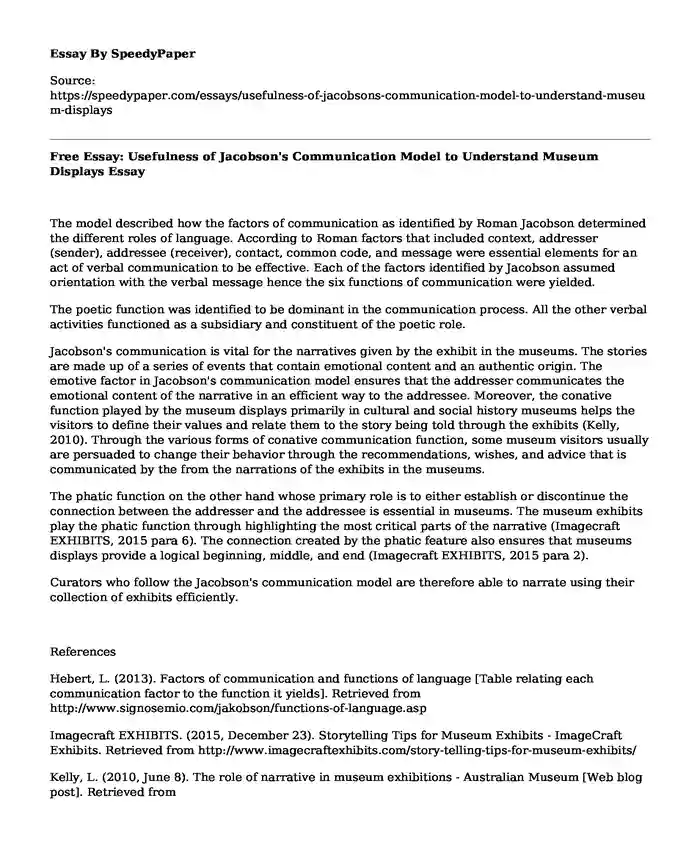
| Type of paper: | Essay |
| Categories: | Communication Art |
| Pages: | 2 |
| Wordcount: | 401 words |
The model described how the factors of communication as identified by Roman Jacobson determined the different roles of language. According to Roman factors that included context, addresser (sender), addressee (receiver), contact, common code, and message were essential elements for an act of verbal communication to be effective. Each of the factors identified by Jacobson assumed orientation with the verbal message hence the six functions of communication were yielded.
The poetic function was identified to be dominant in the communication process. All the other verbal activities functioned as a subsidiary and constituent of the poetic role.
Jacobson's communication is vital for the narratives given by the exhibit in the museums. The stories are made up of a series of events that contain emotional content and an authentic origin. The emotive factor in Jacobson's communication model ensures that the addresser communicates the emotional content of the narrative in an efficient way to the addressee. Moreover, the conative function played by the museum displays primarily in cultural and social history museums helps the visitors to define their values and relate them to the story being told through the exhibits (Kelly, 2010). Through the various forms of conative communication function, some museum visitors usually are persuaded to change their behavior through the recommendations, wishes, and advice that is communicated by the from the narrations of the exhibits in the museums.
The phatic function on the other hand whose primary role is to either establish or discontinue the connection between the addresser and the addressee is essential in museums. The museum exhibits play the phatic function through highlighting the most critical parts of the narrative (Imagecraft EXHIBITS, 2015 para 6). The connection created by the phatic feature also ensures that museums displays provide a logical beginning, middle, and end (Imagecraft EXHIBITS, 2015 para 2).
Curators who follow the Jacobson's communication model are therefore able to narrate using their collection of exhibits efficiently.
References
Hebert, L. (2013). Factors of communication and functions of language [Table relating each communication factor to the function it yields]. Retrieved from http://www.signosemio.com/jakobson/functions-of-language.asp
Imagecraft EXHIBITS. (2015, December 23). Storytelling Tips for Museum Exhibits - ImageCraft Exhibits. Retrieved from http://www.imagecraftexhibits.com/story-telling-tips-for-museum-exhibits/
Kelly, L. (2010, June 8). The role of narrative in museum exhibitions - Australian Museum [Web blog post]. Retrieved from https://australianmuseum.net.au/blogpost/museullaneous/the-role-of-narrative-in-museum-exhibitions
Tribus, A. C. (2017). The Communicative Functions of Language: An Exploration of Roman Jakobson's Theory in TESOL.
Cite this page
Free Essay: Usefulness of Jacobson's Communication Model to Understand Museum Displays. (2022, Mar 14). Retrieved from https://speedypaper.com/essays/usefulness-of-jacobsons-communication-model-to-understand-museum-displays
Request Removal
If you are the original author of this essay and no longer wish to have it published on the SpeedyPaper website, please click below to request its removal:
- Sheet Music and Copyright Law - Free Essay
- Essay Example on Assessing the Competitiveness of StopNShop Today
- Personal Essay Example: A Skeleton in the Closet
- Free Essay: Memory Analysis and The Notebook Movie
- The role of Pope Gregory Vii in Reforming the Spiritual Life of the Religious
- Free Essay on John Deere GPS Systems
- Essay Sample on Prevalence and Effects of White Privilege in Modern Day
Popular categories




